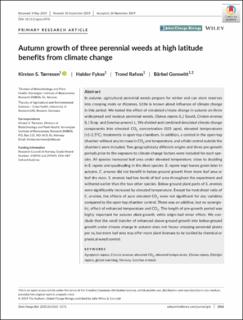| dc.contributor.author | Tørresen, Kirsten | |
| dc.contributor.author | Fykse, Haldor | |
| dc.contributor.author | Rafoss, Trond | |
| dc.contributor.author | Gerowitt, Bärbel | |
| dc.coverage.spatial | Norway | en_US |
| dc.date.accessioned | 2020-03-20T09:59:57Z | |
| dc.date.available | 2020-03-20T09:59:57Z | |
| dc.date.created | 2020-02-28T19:49:19Z | |
| dc.date.issued | 2019 | |
| dc.identifier.citation | Global Change Biology. 2019, 1-12. | en_US |
| dc.identifier.issn | 1354-1013 | |
| dc.identifier.uri | https://hdl.handle.net/11250/2647751 | |
| dc.description.abstract | In autumn, agricultural perennial weeds prepare for winter and can store reserves into creeping roots or rhizomes. Little is known about influence of climate change in this period. We tested the effect of simulated climate change in autumn on three widespread and noxious perennial weeds, Elymus repens (L.) Gould, Cirsium arvense (L.) Scop. and Sonchus arvensis L. We divided and combined simulated climate change components into elevated CO2 concentration (525 ppm), elevated temperatures (+2–2.5°C), treatments in open‐top chambers. In addition, a control in the open‐top chamber without any increase in CO2 and temperature, and a field control outside the chambers were included. Two geographically different origins and three pre‐growth periods prior to the exposure to climate change factors were included for each species. All species increased leaf area under elevated temperature, close to doubling in E. repens and quadrupling in the dicot species. E. repens kept leaves green later in autumn. C. arvense did not benefit in below‐ground growth from more leaf area or leaf dry mass. S. arvensis had low levels of leaf area throughout the experiment and withered earlier than the two other species. Below‐ground plant parts of S. arvensis were significantly increased by elevated temperature. Except for root:shoot ratio of C. arvense, the effects of pure elevated CO2 were not significant for any variables compared to the open‐top chamber control. There was an additive, but no synergistic, effect of enhanced temperature and CO2. The length of pre‐growth period was highly important for autumn plant growth, while origin had minor effect. We conclude that the small transfer of enhanced above‐ground growth into below‐ground growth under climate change in autumn does not favour creeping perennial plants per se, but more leaf area may offer more plant biomass to be tackled by chemical or physical weed control. | en_US |
| dc.language.iso | eng | en_US |
| dc.rights | Navngivelse 4.0 Internasjonal | * |
| dc.rights.uri | http://creativecommons.org/licenses/by/4.0/deed.no | * |
| dc.subject | Agropyron repens | en_US |
| dc.subject | Cirsium arvense | en_US |
| dc.subject | Elevated CO2 | en_US |
| dc.subject | Elevated temperature | en_US |
| dc.subject | Elymus repens | en_US |
| dc.subject | Norway | en_US |
| dc.subject | Sonchus arvensis | en_US |
| dc.subject | Global warming | en_US |
| dc.subject | Eltrigia repens | en_US |
| dc.title | Autumn growth of three perennial weeds at high latitude benefits from climate change | en_US |
| dc.type | Peer reviewed | en_US |
| dc.type | Journal article | en_US |
| dc.description.version | publishedVersion | en_US |
| dc.rights.holder | © 2019 The Authors | en_US |
| dc.subject.nsi | VDP::Landbruks- og Fiskerifag: 900 | en_US |
| dc.source.pagenumber | 1-12 | en_US |
| dc.source.journal | Global Change Biology | en_US |
| dc.identifier.doi | 10.1111/gcb.14976 | |
| dc.identifier.cristin | 1798562 | |
| dc.relation.project | Norges forskningsråd: 299695 | en_US |
| dc.relation.project | Norges forskningsråd: 158934 | en_US |
| dc.relation.project | EC/H2020/771134 - ERA-NET Cofund SusCrop | en_US |
| cristin.ispublished | true | |
| cristin.fulltext | original | |
| cristin.qualitycode | 2 | |

